New Edge browser brings next-gen web to your Windows PC
Microsoft's latest browser, part of Windows 10 Creators Update, adds new web tech for virtual reality, video chatting and better online gaming.

With Edge, Microsoft is modernizing its browser.
Microsoft is working hard to make sure its new Edge browser isn't dogged by the living-in-the-past reputation its older Internet Explorer suffers.
The new Edge, which begins shipping Tuesday as part of Microsoft's Windows 10 Creators Update, adds some new features that are easier to spot, like the ability to stash away a bunch of tabs for later use or show thumbnail previews of tabs to find the one you want.
But many of the most important changes are happening under the hood. You may not see them today, but they'll unlock new web technologies like virtual reality and gaming so developers can build websites of the future.
It's the kind of change that powers the perpetual re-invention of the web. Even though we love our mobile apps, the web remains vital as a universal foundation that works on every phone, laptop and tablet -- just about everything except Apple TV. You may prefer a mobile app for connecting to Facebook or your bank, but the web is still likely to be the way you peruse a new restaurant's menu, see if the hardware store is still open and investigate whether it's better to heat or ice your bad back.
New technologies supported in the latest version of Microsoft Edge make the web more interactive and sophisticated. Among them:
- WebVR, which brings a web interface to virtual reality headsets.
- Web Payments, which makes e-commerce easier.
- WebRTC, which powers online video, audio and text communications.
- Web Authentication, which lets websites authenticate your identity with Windows Hello face recognition.
- And Web Assembly, which makes it possible to bring games and other performance-critical software to the web.
The web changes slowly, so you may not appreciate just how radically different it looks now. In recent years, it's been improved as browsers added support for custom fonts, high-res images, built-in video and audio, flexible but magazine-like layouts, graphics that fade in and slide around when you scroll, webcam control and online chatting. The core ideas of the web remain, but it's become a vastly richer foundation.
WebVR brings 3D immersive worlds, like this fly-through of Sechelt, British Columbia, to the browser.
With Internet Explorer, Microsoft's browser was so tarnished by a reputation of sluggishness and obsolescence that the company chose to start over with its new Edge browser. It stripped IE back to its basic core and started over, and the results are starting to show.
Microsoft still ships both IE and Edge with Windows, but Edge is the future, and it's gradually supplanting IE. Since its arrival in July 2015, Edge usage has risen to 3.3 percent of personal computer and tablet website usage, according to web analysis firm StatCounter. Over that same period, IE usage dropped from 17.2 percent to 8.5 percent. (Google's Chrome accounted for the lion's share of the growth.)
Microsoft is moving a lot faster these days, but Edge still lags Mozilla Firefox and Google Chrome when it comes to support for new standards. Both those browsers support progressive web apps, which let web apps work even when there's no network connection, can make websites load faster, and offer a way to send push notifications.
But while Edge isn't on the bleeding edge, it's much more competitive. Progressive web app support is a top-three priority list item for developer versions of the browser this year, Microsoft said.
CNET Magazine: Check out a sample of the stories in CNET's newsstand edition.
Solving for XX: The industry seeks to overcome outdated ideas about "women in tech."

